CD, CD Çalar, DVD, DVD Çalar, SACD, LP, Plak Çeşitleri ve Fiyatları

We’re resurrecting The Breakdown where we show you all the parts in a dance music classic. To reignite the engine, we’re heading back to the turn of the century and giving The Breakdown treatment to a genuine garage classic.
In the year 2000, London-based producer Jason Chue – aka Wookie – released a track that perfectly combined the fast-growing UK garage sound with a soulful gospel influence.
Upon its debut ‘Battle’ reached number 10 on the UK Singles chart and entered the Top 100 of many European countries, cementing Chue’s place as one of UKG’s pioneers and innovators. It features vocals by Lain and was recorded at disco/funk/soundsystem legend Soul II Soul’s London studio, where Wookie was a writer-producer.
Musically, ‘Battle’ is an emotional rollercoaster that goes from sarcastic-sounding musical theatre-esque vocal sections to deep FM bass drops. There are also church-style vocal choruses, key changes in the middle of the track, and much more.
This may sound complex, but in reality, the track is a true beacon for the “less is more” aspect of production. A little goes a long way.
If anyone ever argues that a banger needs at least 30 audio and MIDI tracks we can confidently recommend that you play them this track! Kick, hats, snare, bass, funky keys, a drone, strings, vocals, and you’re good to go…
As it is considered to be one of the greatest ever UKG productions, we’ll be giving ‘Battle’ the full Breakdown treatment and looking at all of its parts including the lead vocals’ and backing vocals’ melodies.
Chapters
Intro
Drums & FM bass
B Section
Vocals & Harmonies
[advert]
‘Battle’ Intro
Over five minutes the song has two main sections; an intro, a B section and then the intro section repeated at the end. The first minute is definitely misleading because it sounds almost sarcastically happy, with a major chord being played by the drone and a very cheesy plucked string part. A DJ wanting to play more “badass” tracks might even skip over this song after hearing this intro!
The drone is formed of the A# Major triad chord notes A#, D, F with occasional D notes also coming in and out. It’s used throughout the track, with its octave being raised at various points. We used Ableton’s Chord Eno Pad preset to recreate it.
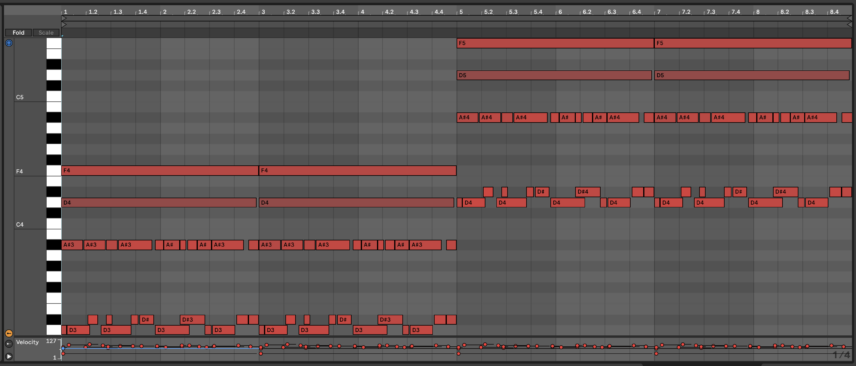
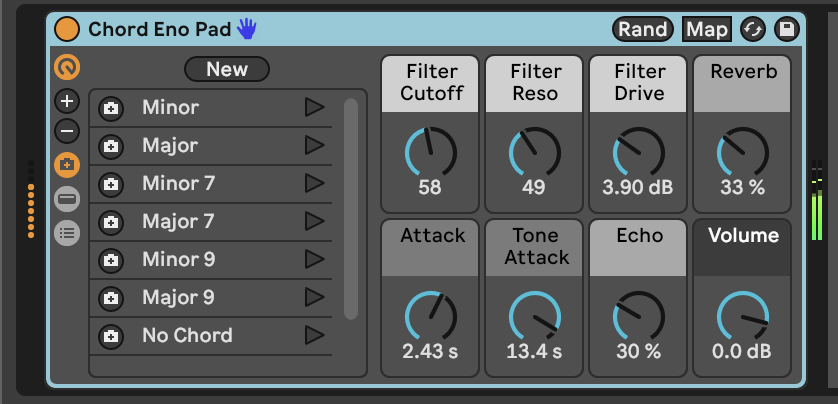
The plucked (or pizzicato) strings are also emphasizing A# by playing the note on every quarter note. We used Ableton’s Pizzicato String Instrument preset for this sound, but any string instrument with a Pizzicato expression setting would do the job.
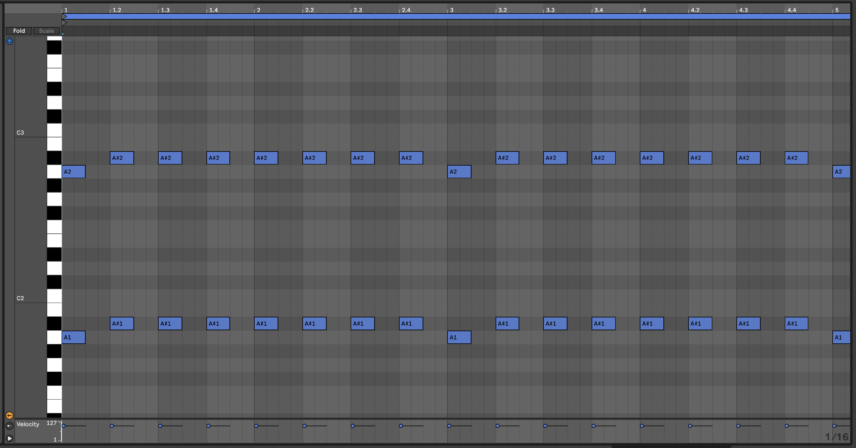
Alone, it almost sounds like an intro to an ad!
When the lead vocal comes in he imitates the rhythm and notes of the strings, which again add to the overtly happy aspect of the section. In the examples we’re going to use a synth lead sound to play the lead vocal’s melody notes.
Here are all three sounds together:
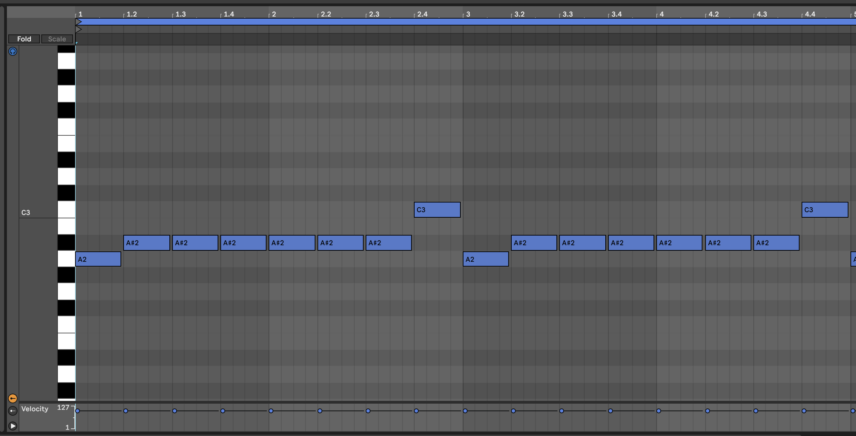
Before the first bass drop at 0:59, the backing vocals make an appearance to introduce some tension. The first one layers the lead vocal’s A# note with a D note and the second one adds a repeating F note. The three together again form the A# major triad.
Here are all vocals with the strings also playing (we used a piano sound for the backing vocals):
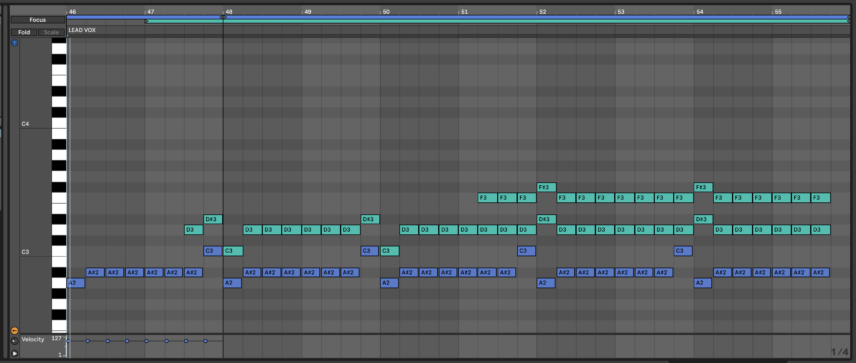
We’re getting into some music theory talk here, but the main message is that all parts are emphasizing the simplest form of the A# major chord and this is what creates a happy and slightly cheesy vibe. This is important to note because of the contrasting parts that come later!
[advert]
Drums & FM Bass In ‘Battle’
The drums in this track are one of its biggest examples of effective simplicity. There are no fancy fills or percussion and the focus is solely on the same repeating kick-hats-snare groove.
The blatantly UKG-style beat is four bars long and the only part that slightly varies across the four bars is the kick. Otherwise, the close hats are playing straight 16th notes, there’s a classic open hi hat on every upbeat, and the snare is hitting on the two and four of every bar.
The trick that brings us into garage territory is adding some 16th-note swing to this pattern – we used Ableton’s ‘Swing 16ths 57’ groove applied to the whole rack.

Here’s the beat with swing:
And here it is without swing:
The difference is subtle, but it literally changes what genre the track is!
Speaking of genre traits, one of the most classic bass sounds in UKG is FM-style bass. This sound had a big resurgence in commercial house worldwide in the 2010’s but there can be no arguing that UK dancefloors have always enjoyed the FM sound.
In Battle, the FM bassline appears at 00:58 and plays in solo with the drums. The sound is so powerful that it is enough to have this section considered as a drop! What’s more, even though it’s playing very similar notes to the plucked strings it just sounds more intense.
We recreated the bassline using Ableton’s aptly named FmHouzBass preset. The main parameters to tweak are the Filter Cutoff and the Filter Env, as the envelope is key to the character of the sound. If you listen for it you can hear lots of automation on these parameters throughout Battle.
Here are the bass and drums together:
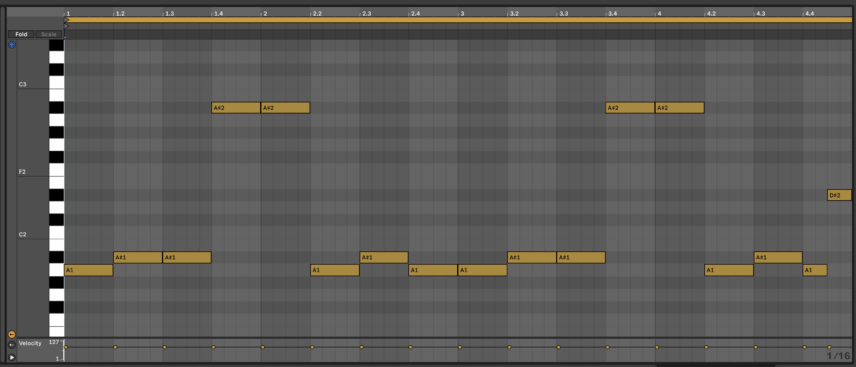
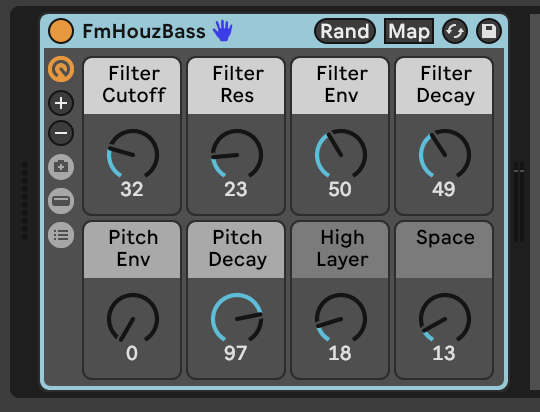
As this bassline continues the vocals, strings and drone we previously looked at come back in over it.
[advert]
‘Battle’ The B Section
At the 1:40 mark, after the second culmination of the backing vocals, there is a kick fill and we find ourselves in a brand new funky section. This section introduces a new chord progression, a keys parts, a bouncier bassline, and a much more melodic style of singing for the lead vocal.
Here’s our recreation of this section without vocal parts:
The chord progression changes from the single A# Major chord to a C Minor – G# Major pattern. Even this is a huge difference, because you’re going from a very happy singular major chord to a more serious minor chord progression.
The progression is mainly made clear by the bassline, which is now much busier and plays some variations or fills at times.
Here’s the main bassline:
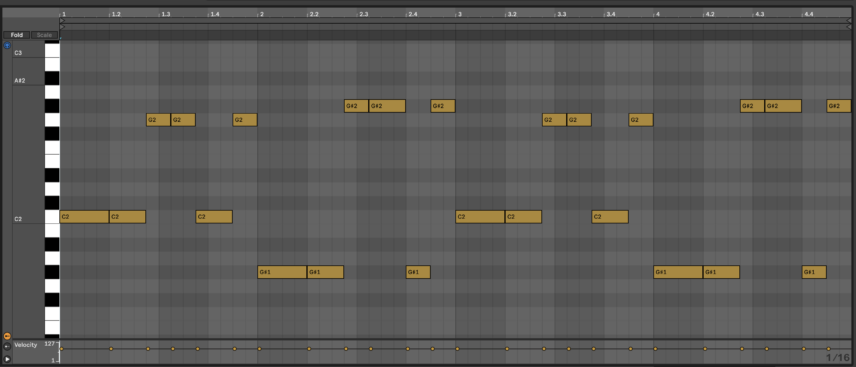
And here are a couple of its variations:
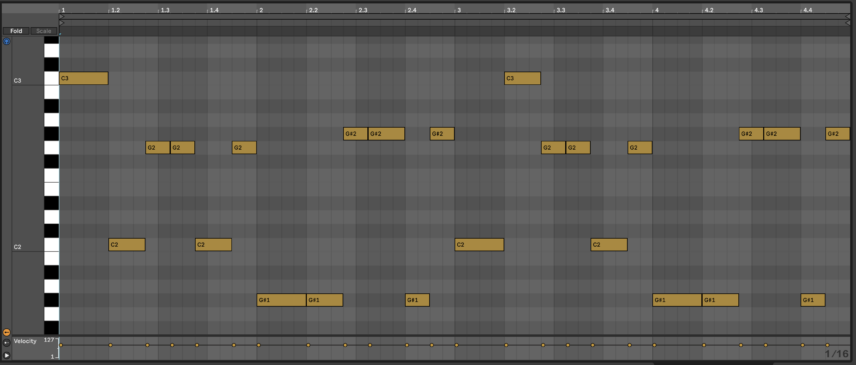
The keys are the other protagonist of this section, raising the amount of funk to unholy levels! Most likely they were recorded with a Rhodes or Wurlitzer keyboard, which were and still are common pieces of gear in London studios.
The rhythmic aspect is paramount, but the note choices are quite clever as well. The keys player is basically jamming out different variations of a C Minor 7 chord that includes C, D#, G and A# notes. These notes are all part of the second chord G# Major as well, so it works over both chords.
The one time this changes is at the very end of the fourth bar when they use a transitional B major chord. That chord isn’t even in the C Minor scale so it’s a very intricate trick that leads nicely back to the first bar.
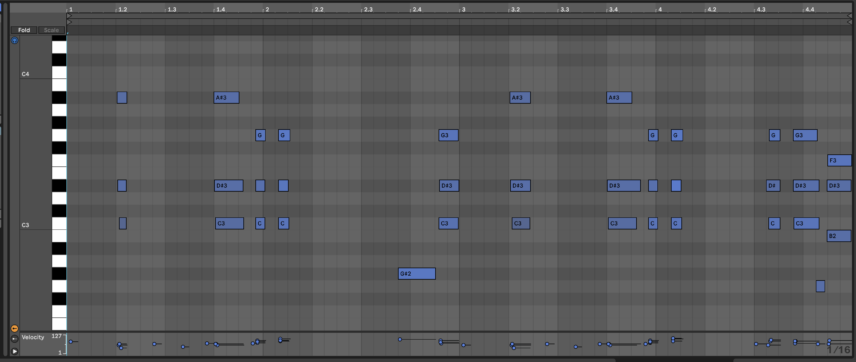
Again focusing on the rhythm, if you just listen to the keys with the drums you can hear how nicely they fill in the gaps left by the kick and snare hits while also catching those main hits at various points. When you have such a good groove and then add a bouncy FM bassline you really can’t go wrong.
[advert]
Vocals & Harmonies
In the B Section the vocals play a much more melodic role, as opposed to strictly hitting every downbeat as they were in the first section.
Here’s the vocal melody over the B Section:
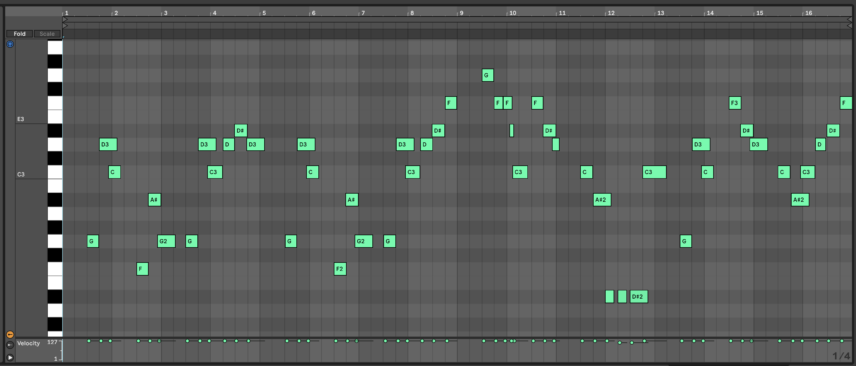
You’ll notice that the vocal notes here are much longer and spread out, compared to all of the musical parts that are based on much faster and busier 16th-notes.
In the second half of the B section, back vocals come in and build up a large harmony of vocals. It sounds like there are two additional harmonies that come in. The first layers the lead’s notes with a perfect 4th interval and the second layers the lead with a higher octave.
This means, for example, when the lead is singing F, the first back vocal is singing A# and the second back vocal is singing the higher F.
Here is the lead vocal (synth lead) with the backing vocals (piano) in solo:
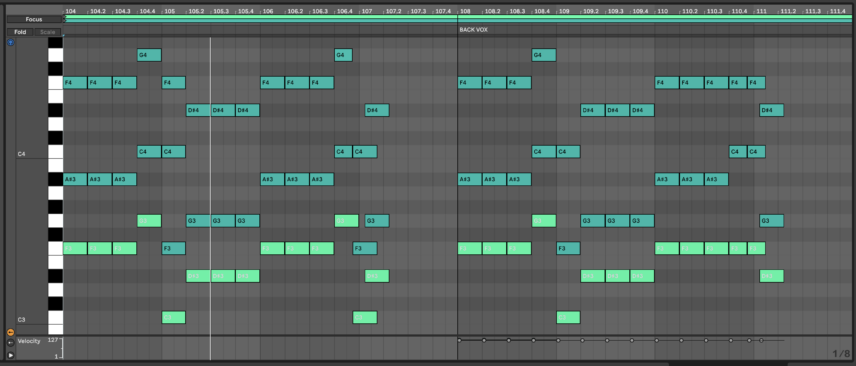
This is a technique rooted in hundreds of years of gospel music and it instantly brings the word ‘soulful’ into the mix. It works even better because of the lyrics, which have the theme of turning to faith in the face of daily struggles and battles.
Here are the vocal harmonies together with the B section’s musical elements:
There is one more big vocal harmony section at 3:12 – this is a short bridge section – and it uses the same harmony technique of stacking perfect 4ths and octaves.
The vocal adlibs also start to become more and more frequent from this point onward, until we go back to the intro section at 4:10.
Wookie’s great arrangement skills really tell a story using all of the elements that we’ve looked at. The result is a unique and driving UKG banger that makes the listener feel uplifted, cool, energetic and positive – all at once!
[social-links heading=”Follow Attack Magazine” facebook=”https://www.facebook.com/attackmag” twitter=”https://twitter.com/attackmag1″ instagram=”https://www.instagram.com/attackmag/” youtube=”https://www.youtube.com/user/attackmag” soundcloud=”https://soundcloud.com/attackmag” tiktok=”https://www.tiktok.com/@attackmagazine”]
[product-collection]
attackmagazine

We’re resurrecting The Breakdown where we show you all the parts in a dance music classic. To reignite the engine, we’re heading back to the turn of the century and giving The Breakdown treatment to a genuine garage classic.
In the year 2000, London-based producer Jason Chue – aka Wookie – released a track that perfectly combined the fast-growing UK garage sound with a soulful gospel influence.
Upon its debut ‘Battle’ reached number 10 on the UK Singles chart and entered the Top 100 of many European countries, cementing Chue’s place as one of UKG’s pioneers and innovators. It features vocals by Lain and was recorded at disco/funk/soundsystem legend Soul II Soul’s London studio, where Wookie was a writer-producer.
Musically, ‘Battle’ is an emotional rollercoaster that goes from sarcastic-sounding musical theatre-esque vocal sections to deep FM bass drops. There are also church-style vocal choruses, key changes in the middle of the track, and much more.
This may sound complex, but in reality, the track is a true beacon for the “less is more” aspect of production. A little goes a long way.
If anyone ever argues that a banger needs at least 30 audio and MIDI tracks we can confidently recommend that you play them this track! Kick, hats, snare, bass, funky keys, a drone, strings, vocals, and you’re good to go…
As it is considered to be one of the greatest ever UKG productions, we’ll be giving ‘Battle’ the full Breakdown treatment and looking at all of its parts including the lead vocals’ and backing vocals’ melodies.
Chapters
Intro
Drums & FM bass
B Section
Vocals & Harmonies
[advert]
‘Battle’ Intro
Over five minutes the song has two main sections; an intro, a B section and then the intro section repeated at the end. The first minute is definitely misleading because it sounds almost sarcastically happy, with a major chord being played by the drone and a very cheesy plucked string part. A DJ wanting to play more “badass” tracks might even skip over this song after hearing this intro!
The drone is formed of the A# Major triad chord notes A#, D, F with occasional D notes also coming in and out. It’s used throughout the track, with its octave being raised at various points. We used Ableton’s Chord Eno Pad preset to recreate it.

The plucked (or pizzicato) strings are also emphasizing A# by playing the note on every quarter note. We used Ableton’s Pizzicato String Instrument preset for this sound, but any string instrument with a Pizzicato expression setting would do the job.
Alone, it almost sounds like an intro to an ad!
When the lead vocal comes in he imitates the rhythm and notes of the strings, which again add to the overtly happy aspect of the section. In the examples we’re going to use a synth lead sound to play the lead vocal’s melody notes.
Here are all three sounds together:
Before the first bass drop at 0:59, the backing vocals make an appearance to introduce some tension. The first one layers the lead vocal’s A# note with a D note and the second one adds a repeating F note. The three together again form the A# major triad.
Here are all vocals with the strings also playing (we used a piano sound for the backing vocals):
We’re getting into some music theory talk here, but the main message is that all parts are emphasizing the simplest form of the A# major chord and this is what creates a happy and slightly cheesy vibe. This is important to note because of the contrasting parts that come later!
[advert]
Drums & FM Bass In ‘Battle’
The drums in this track are one of its biggest examples of effective simplicity. There are no fancy fills or percussion and the focus is solely on the same repeating kick-hats-snare groove.
The blatantly UKG-style beat is four bars long and the only part that slightly varies across the four bars is the kick. Otherwise, the close hats are playing straight 16th notes, there’s a classic open hi hat on every upbeat, and the snare is hitting on the two and four of every bar.
The trick that brings us into garage territory is adding some 16th-note swing to this pattern – we used Ableton’s ‘Swing 16ths 57’ groove applied to the whole rack.
Here’s the beat with swing:
And here it is without swing:
The difference is subtle, but it literally changes what genre the track is!
Speaking of genre traits, one of the most classic bass sounds in UKG is FM-style bass. This sound had a big resurgence in commercial house worldwide in the 2010’s but there can be no arguing that UK dancefloors have always enjoyed the FM sound.
In Battle, the FM bassline appears at 00:58 and plays in solo with the drums. The sound is so powerful that it is enough to have this section considered as a drop! What’s more, even though it’s playing very similar notes to the plucked strings it just sounds more intense.
We recreated the bassline using Ableton’s aptly named FmHouzBass preset. The main parameters to tweak are the Filter Cutoff and the Filter Env, as the envelope is key to the character of the sound. If you listen for it you can hear lots of automation on these parameters throughout Battle.
Here are the bass and drums together:
As this bassline continues the vocals, strings and drone we previously looked at come back in over it.
[advert]
‘Battle’ The B Section
At the 1:40 mark, after the second culmination of the backing vocals, there is a kick fill and we find ourselves in a brand new funky section. This section introduces a new chord progression, a keys parts, a bouncier bassline, and a much more melodic style of singing for the lead vocal.
Here’s our recreation of this section without vocal parts:
The chord progression changes from the single A# Major chord to a C Minor – G# Major pattern. Even this is a huge difference, because you’re going from a very happy singular major chord to a more serious minor chord progression.
The progression is mainly made clear by the bassline, which is now much busier and plays some variations or fills at times.
Here’s the main bassline:
And here are a couple of its variations:
The keys are the other protagonist of this section, raising the amount of funk to unholy levels! Most likely they were recorded with a Rhodes or Wurlitzer keyboard, which were and still are common pieces of gear in London studios.
The rhythmic aspect is paramount, but the note choices are quite clever as well. The keys player is basically jamming out different variations of a C Minor 7 chord that includes C, D#, G and A# notes. These notes are all part of the second chord G# Major as well, so it works over both chords.
The one time this changes is at the very end of the fourth bar when they use a transitional B major chord. That chord isn’t even in the C Minor scale so it’s a very intricate trick that leads nicely back to the first bar.
Again focusing on the rhythm, if you just listen to the keys with the drums you can hear how nicely they fill in the gaps left by the kick and snare hits while also catching those main hits at various points. When you have such a good groove and then add a bouncy FM bassline you really can’t go wrong.
[advert]
Vocals & Harmonies
In the B Section the vocals play a much more melodic role, as opposed to strictly hitting every downbeat as they were in the first section.
Here’s the vocal melody over the B Section:
You’ll notice that the vocal notes here are much longer and spread out, compared to all of the musical parts that are based on much faster and busier 16th-notes.
In the second half of the B section, back vocals come in and build up a large harmony of vocals. It sounds like there are two additional harmonies that come in. The first layers the lead’s notes with a perfect 4th interval and the second layers the lead with a higher octave.
This means, for example, when the lead is singing F, the first back vocal is singing A# and the second back vocal is singing the higher F.
Here is the lead vocal (synth lead) with the backing vocals (piano) in solo:
This is a technique rooted in hundreds of years of gospel music and it instantly brings the word ‘soulful’ into the mix. It works even better because of the lyrics, which have the theme of turning to faith in the face of daily struggles and battles.
Here are the vocal harmonies together with the B section’s musical elements:
There is one more big vocal harmony section at 3:12 – this is a short bridge section – and it uses the same harmony technique of stacking perfect 4ths and octaves.
The vocal adlibs also start to become more and more frequent from this point onward, until we go back to the intro section at 4:10.
Wookie’s great arrangement skills really tell a story using all of the elements that we’ve looked at. The result is a unique and driving UKG banger that makes the listener feel uplifted, cool, energetic and positive – all at once!
[social-links heading=”Follow Attack Magazine” facebook=”https://www.facebook.com/attackmag” twitter=”https://twitter.com/attackmag1″ instagram=”https://www.instagram.com/attackmag/” youtube=”https://www.youtube.com/user/attackmag” soundcloud=”https://soundcloud.com/attackmag” tiktok=”https://www.tiktok.com/@attackmagazine”]
[product-collection]